Hummingbirds are small birds in the family Trochilidae, native only to the Americas. They are known for their ability to hover in mid-air by rapidly flapping their wings. The Giant Hummingbird’s wings beat 8–10 beats per second, the wings of medium sized hummingbirds beat about 20–25 beats per second, and the smallest beat 70 beats per second. Capable of sustained hovering, the hummingbird has the ability to fly deliberately backwards or vertically and to maintain position while drinking from flower blossoms. They are named for the characteristic hum made by their wings.
The hummingbird is a small bird with a long, thin beak. This elongated beak is one of the defining characteristics of the hummingbird, which, with an extendable, bifurcated tongue, has evolved in order to allow the bird to feed upon nectar deep within flowers. A hummingbird’s lower beak also has the unique ability to flex downward to create a wider opening, facilitating the capture of insects in the mouth rather than at the tip of the beak.
Hummingbirds are attracted to many flowering plants—-shrimp plants, Bee Balm, Heliconia, Butterfly Bush, Hibiscus, bromeliads, cannas, verbenas, honeysuckles, salvias, pentas, fuchsias, many penstemons. It is often stated that they are especially attracted to red and yellow flowers. Once attracted to a garden, flowers of other colors may become much more attractive to the hummingbirds. They feed on the nectar of these plants and are important pollinators, especially of deep-throated flowers. Most species of hummingbird also take insects, especially when feeding young.
![]()
The Ruby-throated Hummingbird is by far the most common species that breeds in the eastern half of North America. Ruby-throats are intensely inquisitive and thus easily attracted to feeders, where males in particular typically display aggressive territoriality toward rival hummers, other birds, and even insects such as bees, butterflies, and sphinx moths. They quickly become accustomed to human presence and will swoop down to investigate red articles of clothing, possibly as potential food sources. Feeders hung at windows attract as many visitors as ones farther from structures, and the bird that claims a feeder as its territory may spend much of the day perched nearby, guarding the food source against intruders. Many hummingbird watchers find “Hummer Wars” endlessly entertaining, although the chases are obviously serious business to the hungry birds. For a short period immediately after fledging, a female will tolerate the presence of her own young at the feeder, but they are soon treated the same as other adult birds—as rivals in pursuit of the food necessary to prepare for the fall migration. Courtship is apparently very brief, if it exists at all, and once mated the female raises the young alone. The walnut-sized nest, built by the female, is constructed on a foundation of bud scales attached to a tree limb with spider silk; lichens camouflage the outside, and the inside is lined with dandelion, cattail, or thistle down. The nest will stretch to contain the growing nestlings and may sometimes be reused (rebuilt) the following year.

Two white, pea-sized eggs are laid two or three days apart, which the female will incubate from 60 to 80 percent of the day for 12-16 days. Reports of the duration of the nestling phase vary from 14 to 31 days, the wide range possibly varying with the availability of food; 18-23 days is normal. When they leave the nest, the chicks are considerably larger than their mothers. They may weigh 4.5 grams, while poor Mom is down to only 2.5 g after the stress of raising them. Since the mother starts incubating the first egg as soon as it’s laid, that chick will hatch and fledge earlier than its sibling; it will remain close to the nest until the other chick is ready to fly. After leaving the nest, fledglings are fed by their mother for about 10 days. It is thought that Ruby-throats live as long as 12 years, but the average is probably 3-5 years.
The male has an emerald green back, iridescent ruby red throat that may appear black under some lighting conditions, gray flanks, and forked tail with no white. The male is smaller than the female, but the female has a longer bill. The female has an emerald green back, white breast and throat, rounded tail with white tips. Ruby-throats breed throughout eastern to midwestern North America, from southern Canada to the Gulf of Mexico. During the winter, they migrate to Mexico, Central America, and on Caribbean islands, although a few remain in the Gulf states and the Outer Banks of North Carolina.
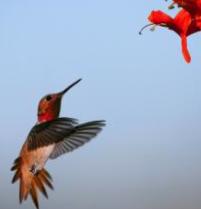
The male is smaller than the female and has a metallic bronze-green head and back, an iridescent coppery-red throat, and rufous flanks. The female has rufous back and sides, a white breast, white throat with some red spots, and a rounded tail with white outer tips. It is observed in Arizona, coastal California and Channel Islands, Georgia, Kansas, Louisiana, Massachusetts (Nantucket), Mississippi, Nevada, Oregon, Tennessee, Texas, Virginia, Vancouver Island, B.C.
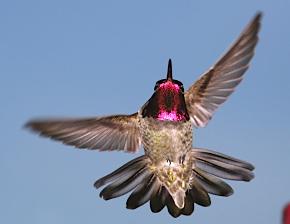
Anna’s is the most common hummingbird in southern California and one of only three species that are permanent residents of the US or Canada (Allen’s and Costa’s are the others). The Anna’s is the largest hummingbird seen on the west coast. The male has a metallic green back, dark rose-red crown and throat, and grayish breast. The female has a green back, grayish-white breast, white throat with some red spots, and white tips on outer tail feathers. These hummers are observed in Alabama, Alaska, Arizona, Arkansas, California, Colorado, Florida, Georgia, Idaho, Kansas, Louisiana, Mississippi, Missouri, Montana, Nevada, New Mexico, Oregon, Tennessee, Texas, Utah, Washington, and British Columbia (resident on Vancouver Island).
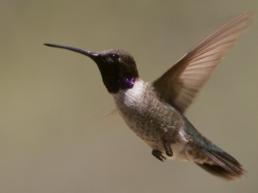
The male has a metallic green back, crown, and breast, black throat with purple throat band, and white collar. The black-chinned is the least colorful of US hummers. The female has a green back and crown, white breast, white throat with some black spots, buff sides, and white tips on outer tail feathers. It is observed in Alabama, Arizona, Arkansas, California, Colorado, Florida, Georgia, Idaho, Kansas, Louisiana, Mississippi, Missouri, Montana, Nevada, New Mexico, Oklahoma, Oregon, Tennessee, Texas, Utah, Washington, Wyoming, British Columbia, and Saskatchewan.
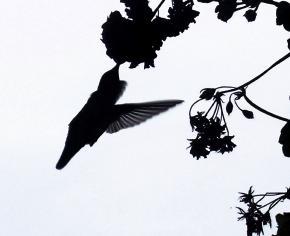
The male has a green back and crown, dark gray breast, bright blue throat, dark blue tail with white outer tips, and thin white stripes above and below the eyes. The female has a green back and crown, gray breast, white tips on outer tail feathers, and thin white stripes above and below the eyes. These hummers are observed in Arizona, California, Colorado, Louisiana, New Mexico, Texas, and Utah. They migrate to Mexico in the winter.
The male has a dark green back, crown, and breast; bright metallic blue throat; and a bright red-orange bill with black tip. The female has a green back and crown, unmarked gray throat and breast, orange bill, and white tips on outer tail feathers. The broad-billed is observed in Arizona, California, Colorado, Idaho, Illinois, Louisiana, Michigan, Nevada, New Mexico, Texas, Utah, and Ontario. In the winters it migrates to Mexico.
The male has a metallic green back, crown, and throat; rusty sides, belly, and tail feathers; and white eye ring. The female is almost identical to the male. They are observed in Alabama, Arkansas, Florida, Louisiana, Mississippi, and Texas. The hummers’ winters are spent in eastern coastal Mexico.
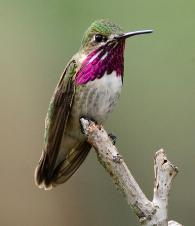
The Calliope prefers high mountains and has been seen as high as 11,000 feet. It builds its nests over creeks or over roads next to streams or lakes, usually repairing the previous year’s nest or constructing a new one atop the old. This bird usually forages within five feet of the ground. Female birds are larger than males. The male has a metallic green back and crown, and white throat with purple rays that may be erected to show a “whiskered” effect. The female has a green back and crown, white throat with dark streaks, buff sides, and white-tipped tail corners. The Calliope is observed in Alabama, Arizona, Arkansas, California, Colorado, Florida, Idaho, Kansas, Louisiana, Minnesota, Mississippi, Montana, Nebraska, New Mexico, North Carolina, Oregon, Tennessee, Texas, Utah, Washington, Wyoming, Alberta, British Columbia, and Saskatchewan. Their winters are spent in west-central Mexico.
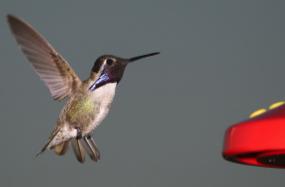
The male has a metallic green back, violet-purple crown and throat with very long side throat feathers, and green breast. The female has a green back and crown, white breast, white throat with some black spots, buff sides, and white tips on outer tail feathers. These hummers are observed in Alaska, Arizona, California, Kansas, Nevada, New Mexico, Oregon, Texas, Utah, and British Columbia. Winters are spent in SE California, SW Arizona, NW Sonora, and Baja. Costa’s don’t migrate very long distances and can be among the first migrant birds to arrive in the spring.
The male has a metallic green back and crown, magenta throat, white breast, buff sides, and long downward-curving bill. The female has a green back and crown, white breast and throat, buff sides, white tips on outer tail feathers, and downward-curving bill. The Lucifer is observed in Arizona, New Mexico, and Texas. Winters are spent in central Mexico.

The Magnificent is the second-largest US hummingbird next to the Blue-throated. The male has a dark green back, purple forehead and crown, metallic green throat, and black breast. The female has an olive green back and crown, gray breast and throat with faint streaking, and pearl-gray tips on outer tail feathers. It is observed in Alabama, Arizona, Arkansas, Colorado, Georgia, Kansas, Minnesota, Nevada, New Mexico, Texas, Utah, and Wyoming. This hummer spends winters in Mexico.
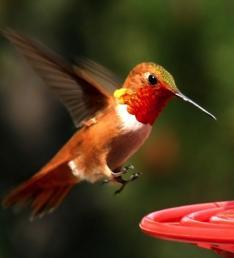
Often described as “feisty,” the Rufous may have the ideal size-to-weight ratio among North American hummingbirds. This bird out flies all other species and usually gets its way at feeders at the expense of slower, less-maneuverable hummers. The Rufous has the longest migration route of all US hummingbirds. The male has a non-iridescent rufous crown, tail, and sides; back may be rufous, green, or some of each; bright orange-red throat; and white breast. A green-backed Rufous cannot be reliably separated from Allen’s in the field without extensive experience and a good view of the spread tail feathers through a scope. The female has a green back and crown, white breast, streaked throat, rufous sides and base of tail feathers, and white tips on outer tail feathers. It is very similar to female Allen’s and Broad-tailed. Females are larger than males. The Rufous is observed in every state and province except Hawaii, Prince Edward Island, and Quebec. The Rufous is the most widely-distributed hummingbird in North America. In the winter they migrate to Mexico and possibly Panama.

The male has an emerald green back, violet-blue crown, unmarked white breast and throat, and red bill with dark tip. The female is almost identical to the male, but crown is slightly less brilliant. It is observed in Arizona, California, New Mexico, and Texas. They migrate to Mexico in the winter.